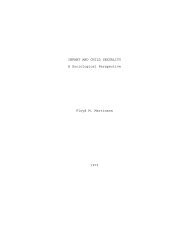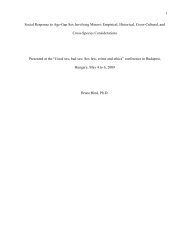PDF file - Ipce
PDF file - Ipce
PDF file - Ipce
Create successful ePaper yourself
Turn your PDF publications into a flip-book with our unique Google optimized e-Paper software.
Book reviews<br />
they come about and their effects. They are focused through the prism of popular culture, but<br />
from there their approaches diverge. Jenkins, a professor at Pennsylvania State University, looks<br />
at the civil liberties costs of ill-conceived legislation passed during sexual panics. Sonenschein, a<br />
former Kinsey researcher, details how society constructs images of pedophiles, children and the<br />
adults who protect them.<br />
PERIODS OF PANIC<br />
Jenkins charts a conventional course in describing how claimsmakers who advocate greater<br />
censure of adult-child sex have used—and been used by—the news media. He breaks no new<br />
ground in reporting how social workers, police and the mental health establishment formulated<br />
exaggerated claims in order to advance budgetary agendas.<br />
Jenkins describes three major child-sex panics in the last 100 years. He shows how beliefs have<br />
shifted profoundly and repeatedly between a relative lack of concern and panic, and says the<br />
reversals mean they are irrational. The result has been,<br />
"Outrage at random violence [against children] is transformed into a largely<br />
symbolic crusade against the nonviolent and thus squanders resources on the<br />
mildly deviant" (p. 9).<br />
Jenkins performs a valuable service in drawing parallels between new laws which resulted from<br />
the latest child-sex panic and their antecedents, such as the now-discredited sex psychopath<br />
laws. The far reaching new measures were enacted in the late 1980s and early 1990s. Despite<br />
their breadth, they have had little historical characterization.<br />
On the other hand, his is a broad-brush approach, superficial and at times inaccurate. For<br />
example, he implies the first federal child-pornography law prohibited mere possession, when in<br />
fact this provision was enacted later (p. 145). This may have been due to his reliance on<br />
inaccurate secondary sources such as the popular press for legal citations.<br />
The book's biggest flaw is that it does not fully illuminate new laws' civil liberties costs, which<br />
go well beyond the groups they target. This may be seen in Jenkins' discussion of the sexually<br />
violent predator statutes.<br />
In effect in more than 16 states and under consideration in more than 20 others, they require civil<br />
commitment, potentially for life, for anyone who may commit a vague array of non-violent<br />
sexual behavior, including, in most states, "any criminal act [found] to have been sexually<br />
motivated" (Lieb & Matson, 1998).<br />
The statutes and mechanisms used to implement them generally exclude incest but are weighted<br />
against homosexuals, a fact not discussed by Jenkins.<br />
http://home.wanadoo.nl/ipce/newsletters/e_14/reviews.htm (2 of 9) [10/16/2002 5:34:25 PM]
















